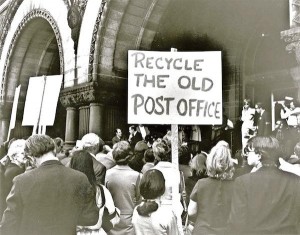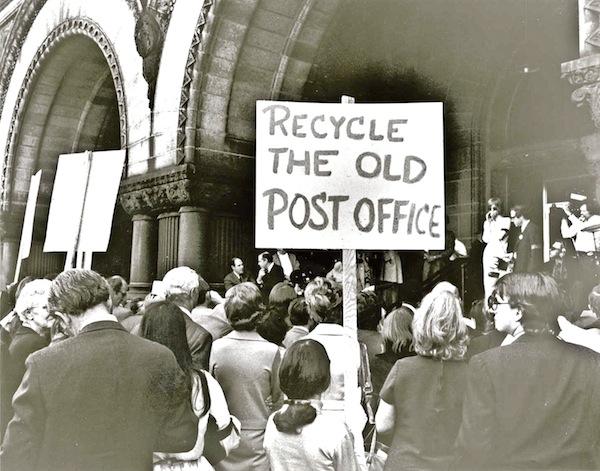By Rebecca Miller, June 1, 2012, Washington Business Journal
 The Romanesque Old Post Office on Pennsylvania Avenue was designed by Willoughby Edbrooke, who died before it was finished in 1899. The project was conceived of under the federal government’s desire to consolidate some of its office space and mail functions into a central location.
The Romanesque Old Post Office on Pennsylvania Avenue was designed by Willoughby Edbrooke, who died before it was finished in 1899. The project was conceived of under the federal government’s desire to consolidate some of its office space and mail functions into a central location.
But this course proved uninformed, as mail functions at the Old Post Office were moved to its new home next to Union Station just 15 years later. Plans to raze the structure began almost immediately, but due to budgetary issues, changes in administration and every other circumstance possible, the Old Post Office held its ground.
By 1971, the Old Post Office was outdated, underused and generally unloved. Forty years later, we have a similar scenario minus the unloved part. Very rarely do I mention the Old Post Office in a lecture or on a tour without someone saying how wonderful he thinks the building is or how she just can’t believe it dodged the wrecking ball on multiple occasions throughout the last century.
Even more surprising to many is that The Trump Organization LLC has been selected by the General Services Administration to redevelop the site. These reactions weren’t that the building would be converted to a luxury hotel, a proposal that has been floated for decades, but that Donald Trump, a kingpin who seems to prefer brass and glass, was selected for this monumental job instead of a more seasoned preservation developer. I like to keep in mind that not every successful developer of historic resources got his or her start doing such projects, so why not give it a shot, right?
The proposal submitted and envisioned by the development team is not a fait accompli. It’s just the starting point for what turns into a complex process of first avoiding, then minimizing and mitigating, any adverse effect to the historic resource this redevelopment might bring. This is known as the Section 106 process under the National Historic Preservation Act of 1966. It gives interested parties the opportunity to voice their opinions and concerns about the proposed project and results in a memorandum of agreement signed by select agencies of the federal government and the D.C. State Historic Preservation Office.
This process will run through the end of the year, and our organization, which has its roots in the Don’t Tear It Down effort that saved the Old Post Office from demolition in 1971, will have a well-earned and vocal place at the table.
We’ve received a lot of calls and emails about the consultation process — the primary concern being that GSA could move this project forward, determine there was an adverse effect and discount what others think. The agency could do that, but in my experience, it won’t. One-quarter of GSA’s portfolio of 1,600 properties is either eligible for or listed in the National Register of Historic Places. The agency really does understand historic buildings and the GSA employees I have worked with truly care about the outcome of the projects.
GSA has even taken steps to educate itself on the current state of the building by engaging local historic preservation consulting firms to update the Historic Structures Report from 1978. This report, which will be produced over the next three to four months, provides documentary, graphic and physical information about the history and existing condition of the Old Post Office building. This guiding document will advise on the most appropriate approach to treatment of the resource, prior to the commencement of work.
One thing I learned recently is that The Trump Organization plans to pursue the 20 percent federal historic tax credit as part of its financing package. This requires the developer to meet the secretary of Interior standards for rehabilitation — a benchmark for successful preservation projects. This is a very positive, clear indication of the developer’s goals for this project.
The objectives are clear: a stellar adaptive reuse project that utilizes the Old Post Office to its maximum potential within the constraints of the historic resource. This is a very high-profile building, with an even higher-profile development team that has tremendous potential for scrutiny. None of it seems easy, but I’m confident that GSA is more than capable of managing the upcoming consulting process that will steer the course of this project for years to come.

